After reviewing Q’s Full Nelson and Half Nelson last August, I was sold on the smaller of their .30 cal suppressors. It would be my next NFA item. But, would it be their direct-thread Half Nelson or the QD Trash Panda? After shooting these two cans (Q cans, two Q cans, toucans?), the decision is made . . .
With Central Texas’ famous Blue Bonnets in full bloom, I headed to the range with my Precision Firearms 6.5 Grendel (the model for most of the photos seen here), a home-built 300 Blackout SBR, and a 16″ .308 bolt gun.
https://youtu.be/MDzzm-C8Lxo
The .30 caliber silencer that I already own is the Dead Air Sandman Ti. I specifically chose a direct-thread can because I enjoy shooting suppressed — given the ability to do so, I’ll favor it every time over unsuppressed — but didn’t want to worry about installing a muzzle brake on every review rifle that came through, or properly installing and correctly timing a brake on every rifle I already owned.
Plus, direct-thread suppressors have traditionally had a much better reputation for maintaining or improving a rifle’s accuracy and exhibiting little-to-no point of impact shift after removing and re-installing the suppressor. This was not the case — especially the POI shift part — with QD suppressors. I was unwilling to sacrifice accuracy or re-zero a rifle every time the suppressor came off and went back on. So Sandman Ti I went.
Fast forward only a few years later and QD suppressor mounting systems have improved dramatically. The focus has shifted from rough and dirty, ratchet- or click-on speed to cutting install time way down while maintaining the repeatable precision of a direct-thread. And it’s that exact repeatability and firm, precise lockup that provides for a consistent point of impact.
In the case of Q’s Trash Panda (a nickname for raccoon) and Thunder Chicken (a nickname for turkey, this is the full-size QD option), the Cherry Bomb Compensator uses traditional threads — it takes five revolutions of the suppressor from off to tight — behind a taper mount. Instead of a square shoulder, the taper increases surface area and better aligns the suppressor. Far less torque is required to enable a complete seal and a suppressor that absolutely will not walk loose.
As seen in the photo above, that taper really does seal up completely. This Cherry Bomb was brand new when I installed it, and while carbon deposits from my first range session are obvious in front of the taper they’re entirely non-existent behind it. The metal is as clean as can be. Some companies put the taper behind the threads, but putting it in front is a much better design. Squeaky clean.
Each of Q’s QD cans comes with two Cherry Bombs, one threaded 5/8×24 and one 1/2×28. Either is installed on or removed from your rifle of choice via that gear-shaped pattern in the muzzle.
Insert 1/2″ socket, then righty-tighty or left-loosey. I found this handy dandy.
Just make absolutely certain that your Cherry Bomb is attached to your rifle more securely than it’s attached to your suppressor. Thanks to the taper mount, the can only needs to be gently hand tight. Don’t go all ‘roid rage on it! If you unscrew your Trash Panda and the Cherry Bomb comes off with it…oy. There’s almost no Cherry Bomb exposed when it’s installed in the suppressor, so good luck removing it.
Likewise, the nifty muzzle design on many of Q’s suppressors not only looks cool, it’s designed to accept a socket wrench or box wrench. A 3/4″, 12-point socket does the trick here. Though, if you properly torque your Trash Panda by hand, you should never need to touch the muzzle with a wrench.
Unless, of course, you’ve decided to run a long handguard way down over the suppressor, as in the photo above. This sort of thing makes the socket-on-the-muzzle access pretty awesome.
Side-by-side, it’s extremely hard to tell the difference between these two Q cans unless you’ve got ’em off the gun and can look in the barrel end. The direct-thread Half Nelson has a much smaller opening, designed to thread onto a 5/8×24-threaded barrel, whereas the Trash Panda has to swallow the whole Cherry Bomb.
If you manage to look closely enough, you’ll notice via the robotic welds that there are 10 baffles in the Half Nelson but only nine in the Trash Panda. This is both to provide room for the Cherry Bomb Compensator and also because the compensator itself acts as the first baffle — the blast baffle.
As a suppressor’s blast baffle suffers the brunt of wear and tear — being blasted by debris and super-heated, high-pressure gas — there’s a strong case to be made for that baffle being replaceable. As in, build it into the muzzle device.
Whether you’re shooting powerful calibers or high volumes of fire or both, that first baffle will eventually wear down. It’s nice when a $75 MSRP part returns it to brand new rather than…well…there ain’t much you can do if it’s the actual first baffle welded into your suppressor.
Installed on the rifle and read-to-shoot, as mentioned, the Trash Panda swallows most of the Cherry Bomb.
It doesn’t look all that different from the firmly-against-the-shoulder Half Nelson. And it doesn’t add very much at all to the installed overall length.
Nope, I can’t tell the difference either.
And that was the same story on the range, too. They don’t sound different, they don’t feel different, they don’t perform different(ly). From behind the gun, I have zero preference whatsoever between the two. Obviously. I can’t tell any difference between the two.
So, at this point I have developed a strong preference for the QD Trash Panda. I like the fast on/off, I like the doesn’t-have-to-be-timed Cherry Bomb muzzle device, and I like that said Cherry Bomb becomes the sacrificial blast baffle. But how about that point of impact shift?
Considering the swirling, unpredictable wind in the quarry where I was shooting, it was a mistake to shoot the above target at 200 yards. However, I wanted to emphasize any POI shift so it would be clearly visible. And I don’t see any.
Six rounds shy of two boxes of Hornady BLACK 123 grain from Freedom Munitions (use code TTAG for 5% off everything on the Freedom Munitions website) went downrange, hitting steel targets at 200 and 258 yards. I then shifted over to my target and sent three rounds at the top left bullseye, removed the Trash Panda with a Silencer Shop “Suppressor Removal Tool,” waved it around, reinstalled it, and shot my final three rounds at the top right bullseye.
Obviously the groups aren’t identical, but I’m calling this POI shift-free. If I’m hunting a hog at 200 yards — heck, a squirrel…or a trash panda…or a frog — I’m making precise hits before and after suppressor removals and installs.
If you want to be really, obsessively precise, the Trash Panda’s muzzle design would allow the use of a torque wrench to install your suppressor identically every. single. time.
In this contest, there is no contest. My next suppressor will be a Q Trash Panda.
Specifications: trash PANDA by Q
Caliber Rating: .30 caliber up to .300 WM
Weight: 11.8 ounces (Cherry Bomb weight: 2 ounces) (Half Nelson weight: 12.2 ounces)
Length: 6.91 inches
Diameter: 1.75 inches
Build: 100% titanium with PVD finish
In The Box: suppressor, 5/8×24 Cherry Bomb, 1/2×28 Cherry Bomb, Q decal, owner’s manual, suppressor pouch
MSRP: $899 (Half Nelson MSRP $868). Less via Silencer Shop.
Ratings (out of five stars):
Overall * * * * *
Like I said in the Half Nelson review, I’d prefer if the barrel side of the Trash Panda were simply a flush base with no protruding, hex-shaped deal. It just isn’t necessary with the wrench-capable muzzle design and I think it would look better. That said, this is the only thing I can think of to nitpick on the Trash Panda. As my favorite .30 cal can available right now — beautifully balancing weight, size, sound suppression, and that fantastic “Quickie™” QD system — the Trash Panda earns a well-deserved five stars.

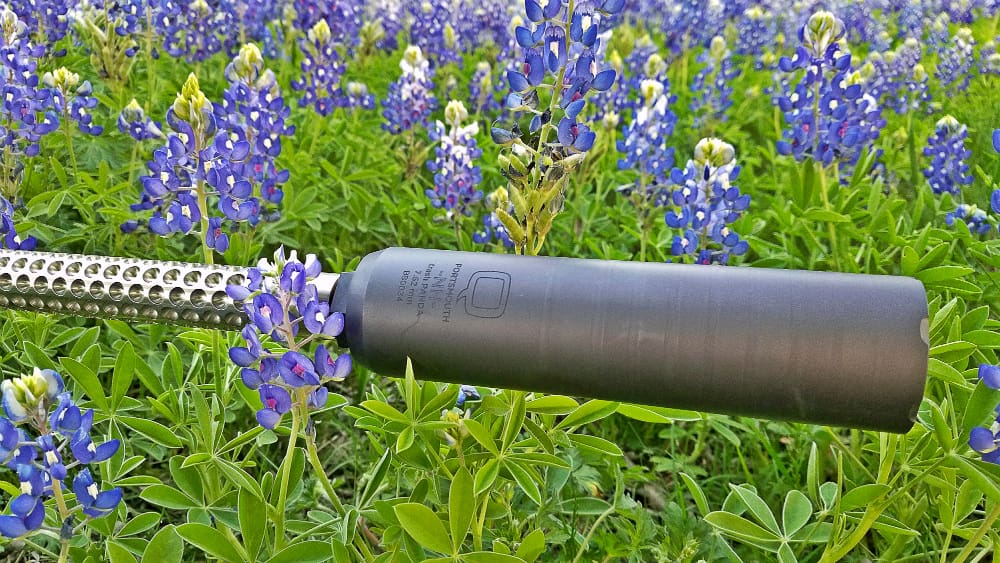
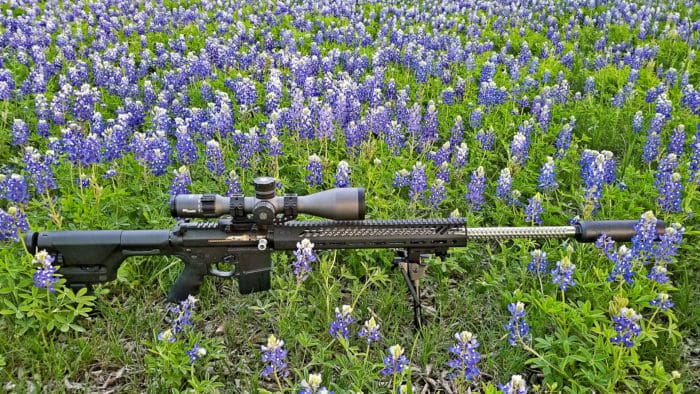
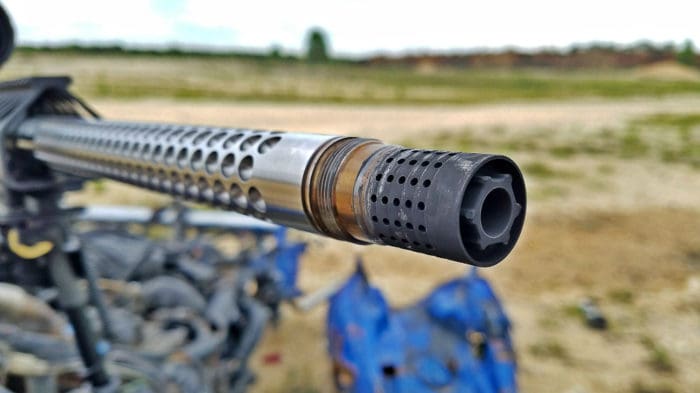
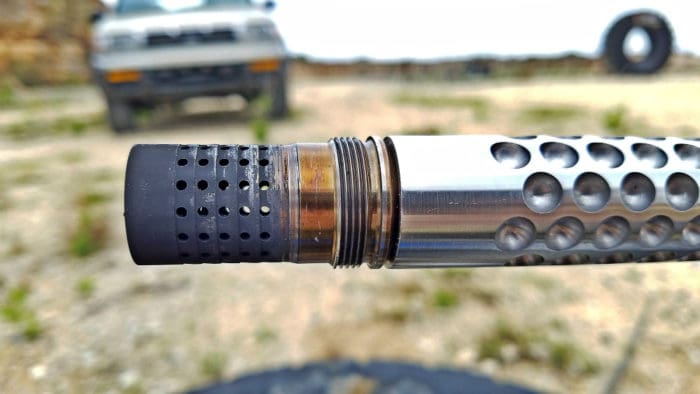



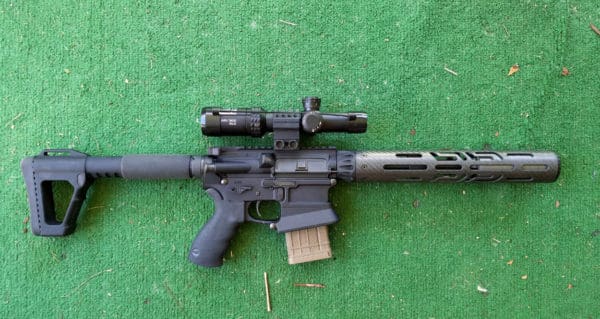
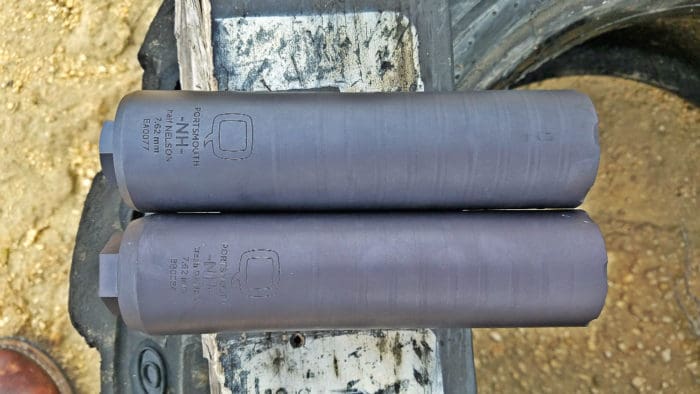
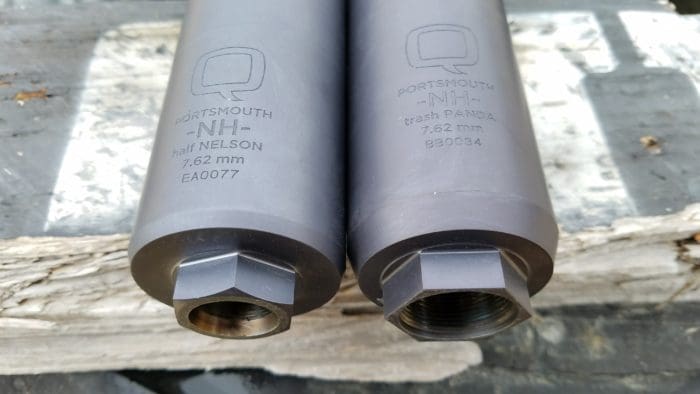
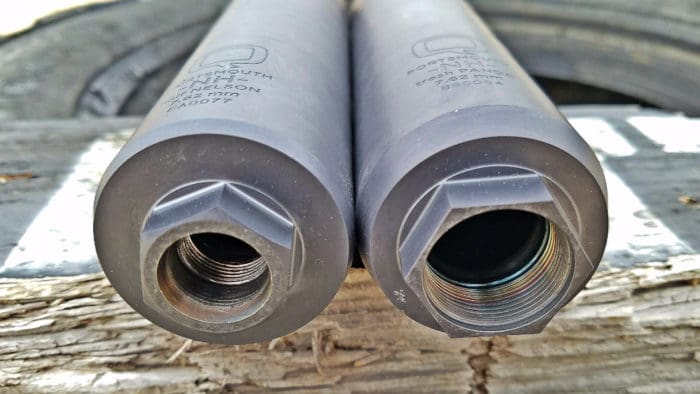
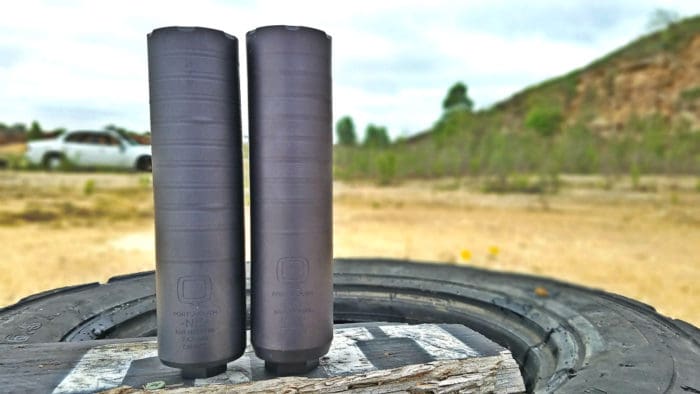
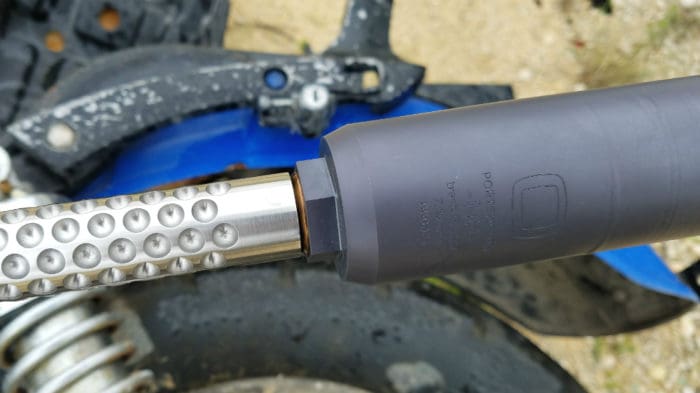
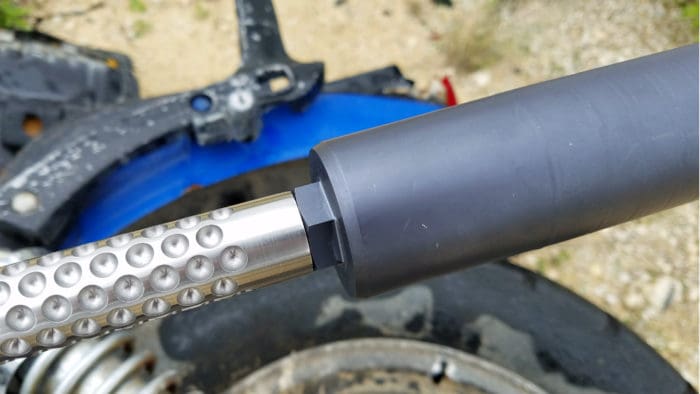
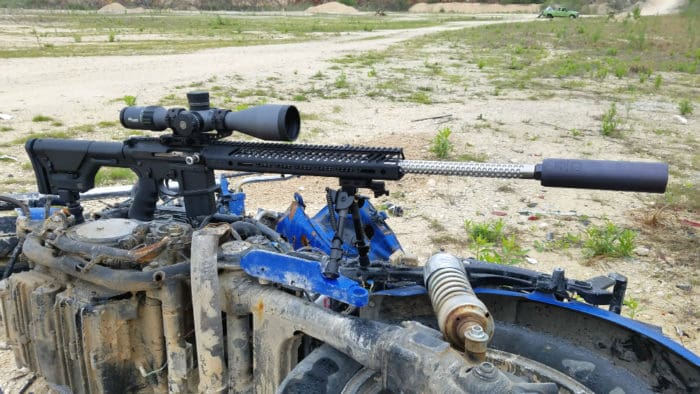
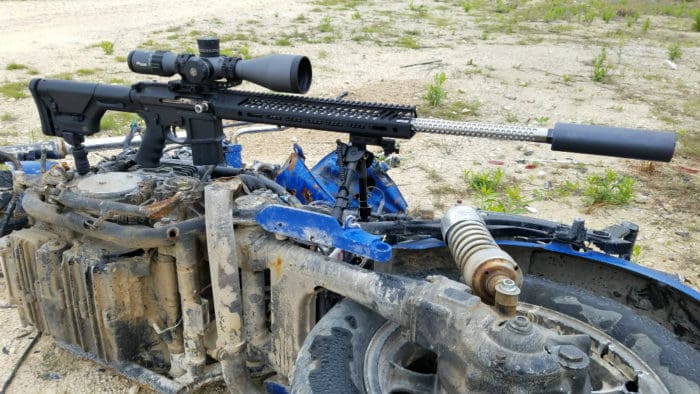
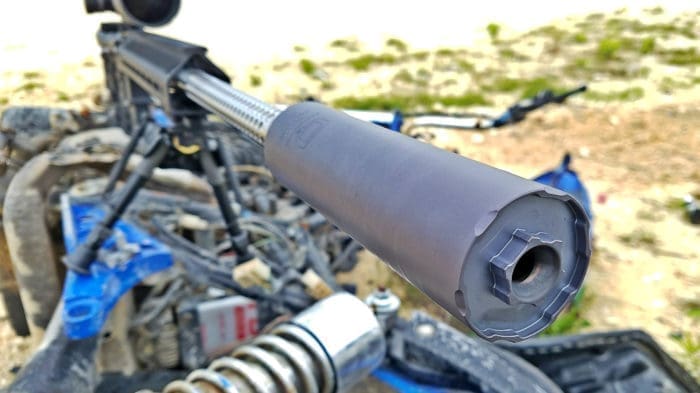
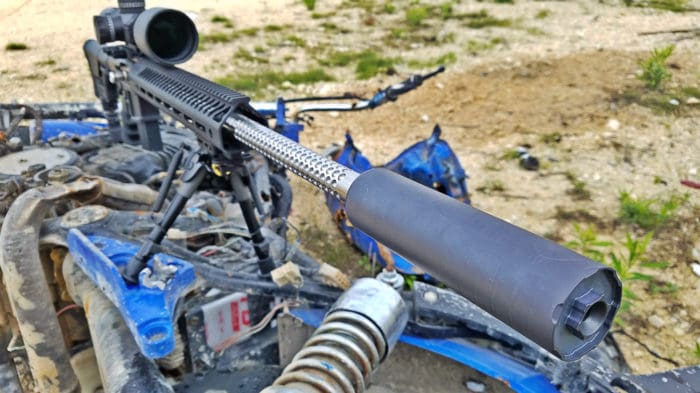
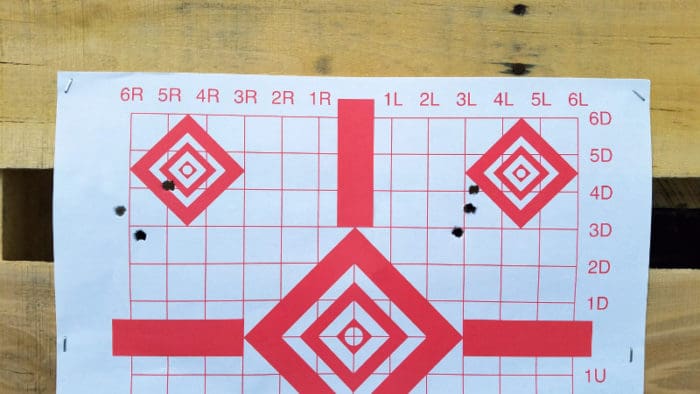
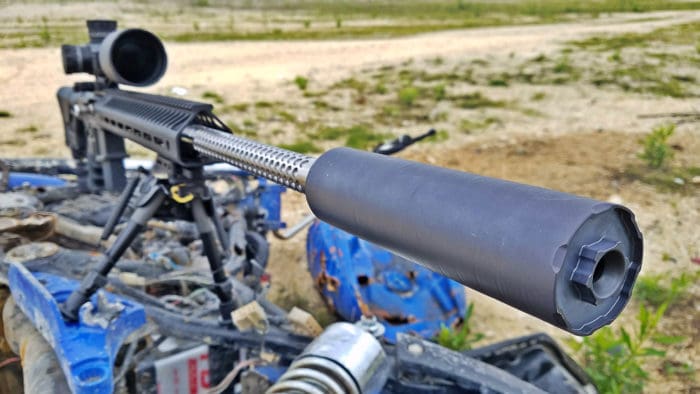
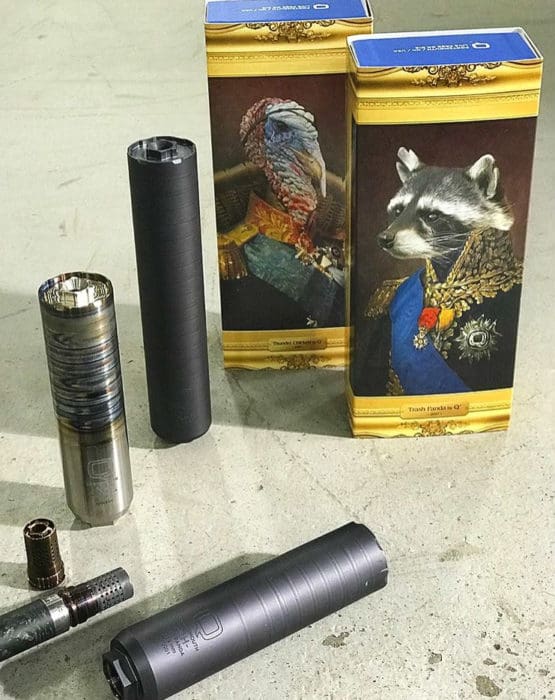



“… it’s designed to accept a socket wrench of box wrench.”
Should that be “…or box wrench.”?
Otherwise, what did that rice-burner bike ever do to deserve a fate like that?
Do y’all have any experience with Amtac suppressors? Would be interested in reviews of their stuff, especially their Hornet 9mm over barrel suppressor
And…why do I still have to enter info every time I comment?
The ones they’ve had at shows with lexan tubes so you can see the internals but they refuse to serialize them because they say they’re non-functional sketch me out. Pretty sure they’d function on plenty of calibers and it never struck me as a wise thing to do.
Hey Jeremy, any Db numbers for the two?
I love my Omega. It even quiets down 5.56 to where I’m comfortable without muffs. Just soft plugs.
dB numbers not yet available. I’ll update when Silencer Shop does their testing…
hmmm must be a redneck runs that company. Cherry bomb (I.e. glasspack mufflers put on mud trucks), Trash Panda (raccoon), Thunder Chicken (Turkey or that weird ass bird on the hood of certain Pontiac muscle cars piloted by Burt Reynolds), Half Nelson, Full Nelson (the WWF oops WCW no dammit WWE is strong with these), and socket wrench install and removal. Yep built for rednecks by rednecks. I’ll take 8!
I picked one up last year when they offered the cost up front until stamp comes in. Should only be another month or so and it will be in my safe… on my 6.8 Wilson.
Also have a Amtac fireAnt that is ready for pickup tfunk so I’ll let ya know what I think once I have time behind it. I have a aac element 2 now but bought he fire Amy for my AR 5.7.
Thanks, they seem like an awesome company from their videos and Facebook page. Very open and informative.
Stumbled across them while looking for a 9mm suppressor for the Sig MPX
I have an MPX Gen 1 and recently got my Amtac Hornet OTB suppressor. Fits well inside the hand guard. Wrench the adapter onto the barrel end first, then spin the can on. Since the adapter goes on left hand and the can goes on right hand if its not tight on the barrel you could have issues. Don’t want to get the adapter stuck up inside the can.
All that said, it shoots very well. Have only been at an inside range and still have headgear on due to others shooting. Want to get it outside to get the better effect. Best part is, according to Amtac it never requires cleaning. Only the FireAnt (22 cal) can must be broken down and cleaned.
Nice very comprehensive reviews! I liked the plethora of nice pics too!
I have several suppressors, a few of them designed and/or made when q worked for the other companies… but really want to get a Q suppressor just because of the guy behind the units.
Who makes that beautiful barrel you have on that rifle?
See note with link in 2nd paragraph: http://www.thetruthaboutguns.com/2017/09/jeremy-s/precision-firearms-enterprise-mod-6-5-grendel-rifle-gun-review/
Jeremy, any possibility of at-ear numbers for the Q to make some apples to apples comparisons? Dead Air focused on at-ear.
I have been waiting for a Dead Air Sandman Ti QD, but the Full Nelson has probably cut that short. The only other can whose numbers I’m curious about as a direct comparison is the Griffin Paladin.
I just wish there was a QD flash hider mount for the Full Nelson.
The Full Nelson is their larger direct thread. The QD equivalent is the Thunder Chicken. The comp is somewhere in the middle between flash hider and brake. It does hands the advantage of acting as a sacrificial blast baffle, whereas a flash hider does very little of that function and most of the blast still his the first suppressor baffle full-on. I think the Cherry Bomb is a good hybrid design.
…dB numbers not yet available. I’ll update when Silencer Shop does their testing…
Ah right, I meant Thunder Chicken. I totally get it re: first blast baffle but wasn’t aware that the Cherry Bomb was anything other than a straight comp. I just don’t want to choose this as the versatile QD can for everything and then be forced to endure obnoxious concussion whenever shooting any of it unsuppressed. So I think I just have to experience it firsthand first. Any plans to measure it in line with your other muzzle brake testing? Thanks for the great reviews.
So I just discovered their “Bottle Rocket,” a thread-on comp for the Cherry Bomb to further comp the comp. If they made a thread-on linear comp or flash hider instead, I’d be all over those. Why not just use the can? Multiple guns, NFA laws.
That and additional thread pitches and I’d be sold.
Already waiting on a thunder chicken but reading this review makes me want to get a trash panda as well…..
Have you tested any of Q’s cans on 5.56 platforms? and in your opinion would getting a trash panda on top of a thunder chicken be over kill?
What handguard is this on thev300blk that allows the panda to slide inside
Comments are closed.